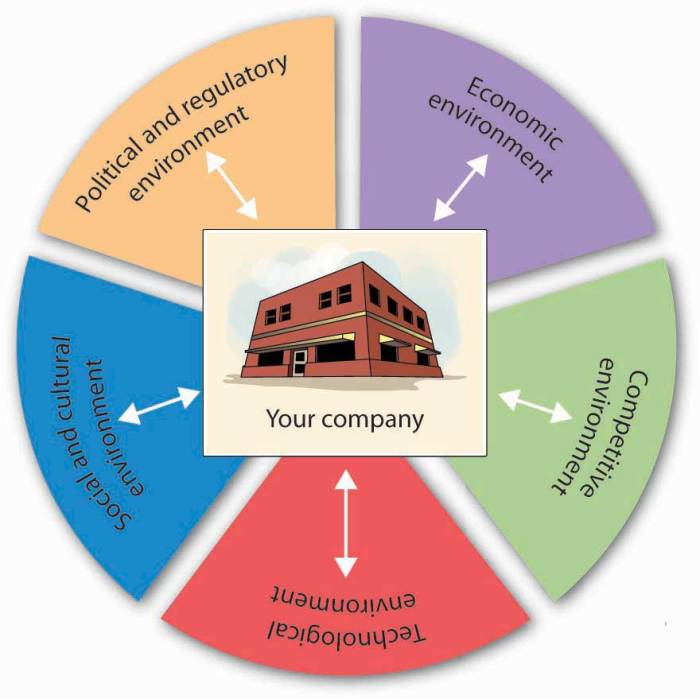
Step into the dynamic world of business environment and innovation where strategies evolve and creativity thrives, promising an exciting journey filled with opportunities and challenges.
The modern landscape of business is constantly shaped by technological advancements and innovative practices, influencing organizational decisions and competitive edges.
Business Environment

In the world of business, the term “business environment” refers to the external factors and forces that affect the operation and success of a company. This includes everything from economic conditions and government regulations to societal trends and technological advancements.
Factors Influencing the Business Environment
- Economic Factors: Changes in the economy, such as inflation rates, interest rates, and unemployment levels, can have a significant impact on businesses.
- Political and Legal Factors: Government policies, regulations, and stability can influence how businesses operate and make decisions.
- Social Factors: Demographic trends, cultural norms, and consumer behavior all play a role in shaping the business environment.
- Technological Factors: The rapid pace of technological innovation can create new opportunities and challenges for businesses.
Impact of Business Environment on Organizational Strategies
- The business environment directly affects the strategies that organizations choose to pursue. For example, a company operating in a highly regulated industry may need to focus more on compliance and risk management.
- Changes in the business environment can also present opportunities for organizations to innovate and differentiate themselves from competitors.
Role of Technology in Shaping the Modern Business Environment
- Technology plays a crucial role in shaping the modern business environment by enabling new business models, improving efficiency, and enhancing customer experiences.
- Technological advancements such as artificial intelligence, big data analytics, and cloud computing have revolutionized how businesses operate and compete in today’s digital world.
Innovation in Business
Innovation in business refers to the process of introducing new ideas, products, services, or methods that result in positive change and value creation within an organization.
Examples of Innovative Practices in Different Industries
- Apple Inc.’s introduction of the iPhone revolutionized the smartphone industry with its touch screen interface and app ecosystem.
- Tesla’s advancements in electric vehicles have disrupted the automotive industry and pushed for sustainable transportation.
- Netflix’s shift from DVD rentals to online streaming transformed the entertainment industry and changed how people consume media.
How Innovation Contributes to a Company’s Competitive Advantage
Innovation plays a crucial role in helping companies stay ahead of their competitors by:
- Creating unique products or services that differentiate them in the market.
- Improving efficiency and productivity through innovative processes and technologies.
- Anticipating and meeting changing customer needs and preferences before competitors do.
Importance of Fostering a Culture of Innovation Within Organizations
Fostering a culture of innovation within organizations is essential for:
- Encouraging creativity and experimentation among employees.
- Promoting continuous improvement and adaptation to market trends.
- Attracting top talent who are drawn to innovative and dynamic work environments.
Relationship between Business Environment and Innovation
In the dynamic world of business, the relationship between the business environment and innovation is crucial for the success and sustainability of organizations. The business environment, which includes factors such as market trends, competition, regulatory changes, and technological advancements, plays a significant role in driving innovation within companies. Similarly, innovative practices can also influence the business environment by shaping industry standards, creating new market opportunities, and enhancing competitive advantage.
How the Business Environment Drives Innovation
- The business environment creates a need for companies to adapt and stay competitive, leading to the development of innovative products and services.
- Market trends and consumer demands in the business environment drive companies to innovate and meet evolving customer needs.
- Technological advancements in the business environment often spark innovation within organizations, pushing them to stay ahead of the curve.
How Innovative Practices Influence the Business Environment
- Companies that embrace innovative practices can disrupt industries, setting new standards and influencing the overall business environment.
- Innovative products and services can create new market opportunities, attracting customers and reshaping the competitive landscape.
- Efficient and creative business processes resulting from innovation can lead to cost savings and improved operational performance, influencing the business environment positively.
How Organizations Can Adapt to Changes in the Business Environment through Innovation
- Organizations can stay agile and responsive to changes in the business environment by fostering a culture of innovation and encouraging employees to think creatively.
- Investing in research and development to continuously innovate and adapt to market trends can help organizations thrive amidst evolving business environments.
- Collaborating with external partners, such as startups or research institutions, can bring fresh perspectives and innovative ideas to help organizations navigate changes in the business environment effectively.
Examples of Companies Navigating the Evolving Business Environment through Innovation
- Apple Inc. is known for its innovative products like the iPhone and iPad, which have revolutionized the tech industry and set new standards for design and functionality.
- Tesla Inc. has disrupted the automotive industry with its electric vehicles and renewable energy solutions, driving innovation and influencing the market environment.
- Amazon has continuously innovated its business model, expanding from an online bookstore to a global e-commerce giant, transforming the retail landscape and setting new benchmarks for customer experience.
Summary

In conclusion, embracing innovation within the ever-changing business environment is key to success, allowing companies to adapt, thrive, and lead in a fast-paced market.
FAQs
How does the business environment impact organizational strategies?
The business environment influences organizational strategies by shaping market conditions, consumer behavior, and competitive landscapes.
Why is fostering a culture of innovation important for companies?
Fostering a culture of innovation encourages creativity, problem-solving, and adaptability, giving companies a competitive advantage in the market.

